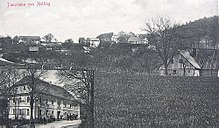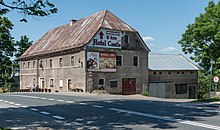Mielnik (Bystrzyca Kłodzka)
| Mielnik | ||
|---|---|---|
 Help on coat of arms |
|
|
| Basic data | ||
| State : | Poland | |
| Voivodeship : | Lower Silesia | |
| Powiat : | Kłodzko | |
| Gmina : | Bystrzyca Kłodzka | |
| Geographic location : | 50 ° 21 ' N , 16 ° 40' E | |
| Height : | 350 m npm | |
| Residents : | ||
| Telephone code : | (+48) 74 | |
| License plate : | DKL | |
| Economy and Transport | ||
| Street : | Kłodzko - Międzylesie | |
| Next international airport : | Wroclaw | |
Mielnik (German Melling ) is a village in the powiat Kłodzki in the Lower Silesian Voivodeship in Poland. It belongs to the municipality of Bystrzyca Kłodzka ( Habelschwerdt ), from which it is six kilometers to the north.
geography
Mielnik is located on the south-west slope of a flat ridge between the valley of the Glatzer Neisse and the Bieletal , which the road from Kłodzko to Międzylesie crosses here. This pass, located about 50 meters above the valley, is called Przelęcz Mielnicka (German Melling Pass ). Neighboring places of Mielnik are Żelazno in the north, Romanowo in the east, Piotrowice in the southeast, Zabłocie in the south, Szklarka in the southwest and Gorzanów in the west. To the north rises the 518 m high Wapniarka ( Weißkoppe ).
history
Melling was first mentioned in 1358 as Melnik . In 1421 it was referred to as Melning and in 1625 as Melnitz . It was parish in Rengersdorf from the beginning and belonged to the Glatzer Land , with which it shared the history of its political and ecclesiastical affiliation. It consisted of a dominial portion and a free judge property .
Around the middle of the 14th century, the dominant part belonged to the knight Hanke von Knoblauchsdorf. Later Melling came to the von Ratold gentlemen. In 1421 Otto, Martin and Hans von Ratold sold half of Melling to the Nickel von Knoblauchsdorf, which at that time owned the later Ratschinhof in Arnsdorf ( Grafenort ). Around 1520 the Ratold brothers sold the second half to the Ratschin brothers, so that from this time onwards all of Melling, with the exception of the Freirichtgut, belonged to the Ratschinhof. 1559 was, along with the Ratschinhof and a share Altwaltersdorf , owned by the Georg von Ratschin, the end of the 16th century, bought up some farm buildings of which it is a Vorwerk made that as the Fritschengütel was called. His son Hans von Ratschin lost a third of his possessions in 1625 because of his participation in the Bohemian uprising . Since he could not redeem this third, Melling came together with the Ratschinhof and the Altwaltersdorf share in 1628 to Johann Arbogast von Annenberg , who already owned the Moschenhof and Schlosshof in Arnsdorf. He formed the rule Grafenort from the acquired shares. In 1638, Melling and the holdings belonging to the Ratschinhof were inherited from the fief . After the rule of Grafenort passed to Johann Friedrich von Herberstein , Melling belonged to the Grafenort majority rule that he had formed .
After the Silesian Wars , Melling and the County of Glatz fell to Prussia in 1763 with the Peace of Hubertusburg . Evidence for the beginning of the 18th century: a stately farm, a Freirichtergut, a limestone quarry, five farmers and 24 gardeners and cottagers . There was a tailor, cobbler and blacksmith each among the residents. At the request of the residents, Melling was detached from the Rengersdorf parish in 1786 and dedicated to the parish church in Grafenort. With the Prussian reforms in 1807 the inheritance was lifted.
After the reorganization of Prussia, Melling belonged to the province of Silesia from 1815 and was initially incorporated into the district of Glatz. In 1818 it was reorganized into the newly formed district of Habelschwerdt , to which it belonged until 1945. In 1939 141 inhabitants were counted.
As a result of the Second World War , Melling, like almost all of Silesia, fell to Poland in 1945 and was renamed Mielnik . The German population was expelled. Some of the newly settled residents were displaced from eastern Poland . 1975-1998 Mielnik belonged to the Wałbrzych Voivodeship (German Waldenburg ).
Freirichtergut
The first owner of the Freirichtgut known by name was Thomas von Melling in 1465. The next free judges came from the Sauer and Egel families. In 1606 it was acquired by Hans Franke, who had previously married Jakob Egel's widow. In 1614 he sold it to Georg Peschke from Arnsdorf, who sold it to Christian Greifenhaben in 1618. In 1625 he was sentenced to 125 thalers for his participation in the Bohemian class uprising and his property was confiscated. It was bought by Kaspar Burghardt in 1630, and it remained with his descendants until 1766, when Johann Christoph Burghard sold it to his son-in-law Johann Josef Läufer from Pohldorf . This was followed by his son Joseph Läufer. At that time, the Freirichtergut included a Kretscham, a tailor, a shoemaker and a blacksmith and a robot gardener.
Attractions
- Trinity column with a depiction of a Pietà in the crown.
Personalities
- Alois Mühlan (1856–1935), writer and educator
literature
- Joseph Kögler : The chronicles of the county Glatz . Revised by Dieter Pohl . Vol. 4, ISBN 3-927830-18-6 , pp. 298-303.
- Verlag Aktion Ost-West eV: The Glatzer Land . ISBN 3-928508-03-2 , p. 73.
Web links
- Historical and current recordings as well as geographical location. Retrieved May 2, 2018 .
Individual evidence
- ↑ Marek Šebela, Jiři Fišer: České Názvy hraničních Vrchů, Sídel a vodních toků v Kladsku . In: Kladský sborník 5, 2003, p. 385
- ↑ Groffschoaftersch Häämtebärnla 2009, p. 16



